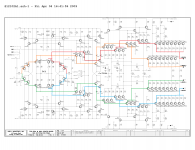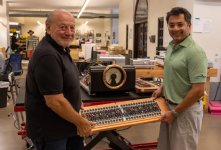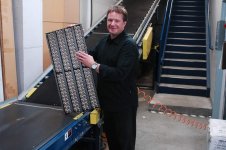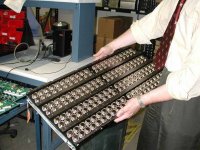any news?I am still looking for commercial audio amplifier brands, where are in use a bunch of small or medium signal transistors in the output power stage instead only one or only few BjT power device in each half.
commercial amp devices seems to be very rare. But where are the best schematics for diy projects in this matter (except the above mentioned and the follow:This approach seems to be very good in view to the sonic quality. Thule's integrated amp IA120 work with a bunch of paralleled TO-126 (unfortunately I haven't the schematic).
Mr. Nelson Pass does basicly the same by this project:
http://www.diyaudio.com/forums/pass-labs/150048-beast-thousand-jfets.html
Who knows more commercial brands with a bunch of small signal transistors in the output power stage instead only one BjT power device in each half?
http://www.diyaudio.com/forums/soli...gh-perfromance-lpuhp-16w-power-amplifier.html )
In respect of ultra low impedance loads this approach seems to be the best from my view.
Thanks for advices.
Very interesting. What about sound? Are there experiences with the use of AD797 in this kind ?
For the output section of Mr Self's design, AD797 would require double the number of opamps and make it rather expensive.
(I picked other opamps for the front end, plus fet-input opamp for the servo instead of OP177, use it as headphone amp for an AKG)
(I picked other opamps for the front end, plus fet-input opamp for the servo instead of OP177, use it as headphone amp for an AKG)
Last edited:
1 thing. The drivers see all those output transistor input capacitance in parallel. Don't know how this compares with one high power transistor.
The main advantage for operating in parallel mode is the absence of the typicall disadvantages in comparsion to MOSFET's.1 thing. The drivers see all those output transistor input capacitance in parallel. Don't know how this compares with one high power transistor.
The actually question is here, what kind of audible effects and distortions occurs on the different circuit topologies (with and without global NFB so as with global NFB only for LTP/VAS like used in Nelson's STASIS series)
An advantage of using many smaller transistors is that secondary breakdown is avoided, so long as adequate current sharing emitter resistors are used. A single power transistor die is large and thermal gradients can build up between different parts of the die leading to hot-spots (the mechanism of secondary breakdown).
Another advantage I can see is that if one device fails short, it will be vaporized quickly by the opposite side devices acting in concert, becoming open circuit and leaving the amp still functioning - cascade failure is less likely. Against this is the fact that failures are more likely with more devices, and severe voltage spikes are going to affect multiple devices anyway.
Another advantage I can see is that if one device fails short, it will be vaporized quickly by the opposite side devices acting in concert, becoming open circuit and leaving the amp still functioning - cascade failure is less likely. Against this is the fact that failures are more likely with more devices, and severe voltage spikes are going to affect multiple devices anyway.
Attachments
check out in this case the first attachment in post #57 (and my question) underAn advantage of using many smaller transistors is that secondary breakdown is avoided, so long as adequate current sharing emitter resistors are used. A single power transistor die is large and thermal gradients can build up between different parts of the die leading to hot-spots (the mechanism of secondary breakdown).
Another advantage I can see is that if one device fails short, it will be vaporized quickly by the opposite side devices acting in concert, becoming open circuit and leaving the amp still functioning - cascade failure is less likely. Against this is the fact that failures are more likely with more devices, and severe voltage spikes are going to affect multiple devices anyway.
https://www.diyaudio.com/community/threads/2n3055-the-early-years.382690/page-3#post-7471091
so it is clearly to understand, why a parallel mode provide benefits regarding the sonic performance while playback of hard beats in the music.
I am looking for commercial amps with many small/medium BjT transistors in the output stage.
Concerning tube power resp. integrated amp there is available in this kind the EAR V20
https://www.ebay.de/itm/274659493402
or V12:
https://www.whathifi.com/ear-yoshino/v12/review
Last edited:
There is a maximum of parallel components. This is because the summation of the diameters over a mostly small optimum (for a defined current, signal) leads to a washed-out, dragged-out sound. In addition, the parallel setting is rarely, and then only randomly, circuit-considering.
And more;-?
And more;-?
I suggest to use some TO-126.check out in this case the first attachment in post #57 (and my question) under
https://www.diyaudio.com/community/threads/2n3055-the-early-years.382690/page-3#post-7471091
so it is clearly to understand, why a parallel mode provide benefits regarding the sonic performance while playback of hard beats in the music.
I am looking for commercial amps with many small/medium BjT transistors in the output stage.
Concerning tube power resp. integrated amp there is available in this kind the EAR V20
https://www.ebay.de/itm/274659493402
or V12:
https://www.whathifi.com/ear-yoshino/v12/review
But for single ended, because (complementary) pp designs rob a lot of dynamics, homogeneity, clarity, resolution... due to the audibly different sound of the two separately, different amplified half-waves.
yes - but this isn't the case, if one would use a PPP or circlotron topology - unfortunately very rarely in commercial solid state resp. transistorized amp products - go to
https://www.diyaudio.com/community/...-of-commercial-solid-state-amplifiers.160869/
TO126 in parallel and push-pull mode was realized in this integrated amplifier (I am looking for the associated schematic):
https://www.diyaudio.com/community/...r-ia-120-ia120-schematic-wanted.157121/page-2
https://www.diyaudio.com/community/...-of-commercial-solid-state-amplifiers.160869/
TO126 in parallel and push-pull mode was realized in this integrated amplifier (I am looking for the associated schematic):
https://www.diyaudio.com/community/...r-ia-120-ia120-schematic-wanted.157121/page-2
Obviously massive amount of BjT's with TO-247 or TO-3 outline in a parallel mode more often to find in commercial amp devices than such with small outline like TO126 - check out the attached imagescheck out in this case the first attachment in post #57 (and my question) under
https://www.diyaudio.com/community/threads/2n3055-the-early-years.382690/page-3#post-7471091
so it is clearly to understand, why a parallel mode provide benefits regarding the sonic performance while playback of hard beats in the music.
I am looking for commercial amps with many small/medium BjT transistors in the output stage.
Concerning tube power resp. integrated amp there is available in this kind the EAR V20
https://www.ebay.de/itm/274659493402
or V12:
https://www.whathifi.com/ear-yoshino/v12/review
Attachments
- Home
- Amplifiers
- Solid State
- Using Many Small Signal Transistors Paralleled in place of one output Transistor




